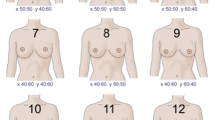Abstract
This study investigates whether tissue recoil or patient intrinsic factors influence the final position of the nipple areola complex (NAC) after reduction mammoplasty.
The age, pre-operative ptosis, BMI and weight of the tissue resected were recorded as patient intrinsic factors in 37 patients undergoing reduction mammoplasty. The “spring-back” value was defined as the distance from the sternal notch to a nipple landmark on the breast meridian with the patient sitting up, minus the same measurement repeated with the patient recumbent to eliminate the pull of gravity on the breast. Spring back was measured pre-operatively for the nipple and nipple mark then post-operative for the nipple. The difference in centimeters between the final post-operative distance from the sternal notch to the nipple and the level intended by the pre-operative nipple mark was termed the “judgment error.” The final position of the post-operative nipple and the judgment error was compared to the spring-back values and patient intrinsic factors.
Pre-operative ptosis was statistically related to increasing patient BMI and mass of tissue resected per breast. Pre-operative spring-back values for the nipple increased with increasing ptosis, BMI and decreasing age. Spring-back values were greater in the lower pole of the breast than in the upper pole. The final position of the nipple was higher than the pre-operative mark in 65% of cases, lower in 8% and as marked in 27% of cases. The post-operative NAC was, on average, 0.6 cm higher than planned pre-operatively. The post-operative distance from the sternal notch to the nipple increased with increasing pre-operative ptosis, mass of breast tissue resected per breast and all three spring-back values. The difference between the level of the pre-operative mark and the final nipple position showed a weak correlation with post-operative spring-back values.
The parameters of ptosis, BMI, weight of tissue resected per breast and pre-operative nipple spring back reflect body habitus and breast size. Spring-back values vary between the upper and lower pole of the breast. The final NAC position was higher than that intended at pre-operative marking in the majority of cases. The surgeon instinctively marks the nipple lower in patients with greater pre-operative ptosis and in whom a larger resection is anticipated. Judgment error did not relate to intrinsic factors nor to pre-operative spring-back values; hence, these parameters cannot be applied as predictive tools for more accurate pre-operative marking of the nipple position. This study suggests that the pre-operative nipple mark should be placed, with the patient sitting up, at least 23 cm from the sternal notch and 0.6 cm lower than the final position estimated using the inframammary crease as a landmark.











Similar content being viewed by others
References
Aufricht G (1949) Mammaplasty for pendulous breasts. Plast Reconstr Surg 4:13
Courtiss E, Goldwyn RM (1977) Reduction mammoplasty by inferior pedicle technique. Plast Reconstr Surg 59:500
Georgiade GS, Riefkohl RE, Georgiade NG (1989) The inferior dermal-pyramidal type breast reduction: long-term evaluation. Ann Plast Surg 23:203
Godwin Y, Wood S, O’Neill TJ (1998) Consultant and patient opinion on the aesthetic outcome of reduction mammoplasty. Br J Plast Surg 51:444
Williams PL (1995) Gray’s anatomy, 38th edn. Churchill Livingstone, New York
McKissock PK (1979) Reduction mammaplasty. Ann Plast Surg 2:321
Penn J (1955) Breast reduction. Br J Plast Surg 7:357
Regnault P (1976) Breast ptosis: definition and treatment. Clin Plast Surg 3(2):193
Robbins TH (1977) A reduction mammoplasty with the areola-nipple based on an inferior pedicle. Plast Reconstr Surg 59:64
Wise RJ (1956) A preliminary report on a method of planning the mammaplasty. Plast Reconstr Surg 17:367
Acknowledgements
Thank you to all the patients at Nottingham City Hospital and The Northern General Hospital, Sheffield, who participated in this study. Thank you to my consultant colleagues at the above hospitals for allowing me to perform this study.
Author information
Authors and Affiliations
Corresponding author
Additional information
An invited commentary on this paper is available at http://dx.doi.org/10.1007/s00238-007-0118-x.
Rights and permissions
About this article
Cite this article
Godwin, Y., del Pilar Schneider, M. The spring-back phenomenon: does the final position of the nipple areola complex correspond to the pre-operative markings in reduction mammoplasty?. Eur J Plast Surg 29, 361–367 (2007). https://doi.org/10.1007/s00238-007-0117-y
Received:
Accepted:
Published:
Issue Date:
DOI: https://doi.org/10.1007/s00238-007-0117-y




